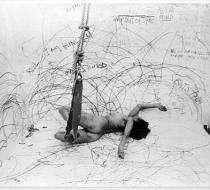Carolee Schneemann, Up to and including her limits, 1973-76 Favorite
Carolee Schneemann is largely associated with her performance art of the 1960s and 1970s, in which she boldly addressed feminist and political issues in ways that shocked and engaged viewers. But she has always maintained that she is a painter, a fact often overlooked in discussions of her larger body of work. At the heart of her approach is her ongoing exploration of the boundaries of painting and drawing, as in Up to and Including Her Limits.
On the genesis of this physically demanding work, Schneemann writes that it was “the direct result of [Jackson] Pollock’s physicalized painting process,” referring to Pollock’s active engagement of his whole body as he flung, dripped, and poured paint over canvases spread on the floor. Dubbed “action painting” by art critic Harold Rosenberg, Pollock’s technique was a touchstone for Schneemann. She developed her own approach to art making in dialogue with action painting, seeking to insert her own body and her own perspective into a historically male-dominated arena.
“I am suspended in a tree surgeon’s harness on a three-quarter-inch manila rope, a rope which I can raise or lower manually to sustain an entranced period of drawing—my extended arm holds crayons which stroke the surrounding walls, accumulating a web of colored marks,” Schneemann writes, describing Up to and Including Her Limits. “My entire body becomes the agency of visual traces, vestige of the body’s energy in motion.”
Schneemann performed Up to and Including Her Limits nine times between 1971 and 1976, eventually turning it into an installation. The work is a record of the lines her suspended body made in space as she moved it up, down, and across expansive sheets of paper placed on the walls and floor of a corner of a room. Alongside the drawing, stacked video monitors show recorded footage of her performances, while the harness and rope that held her body hangs in the center of this display.
Per Schneemann, “I grew up surrounded by the walls of masculine convention and ideology, in which I could be a muse but I could never have authority.”
Iconic image of Schneemann—female empowerment, not for male pleasure “Great Goddess” “challenged the traditional status of women and female bodies in the history of art but also interrogated the relationships between
an artist’s physical body, the work of art, and the audience.







